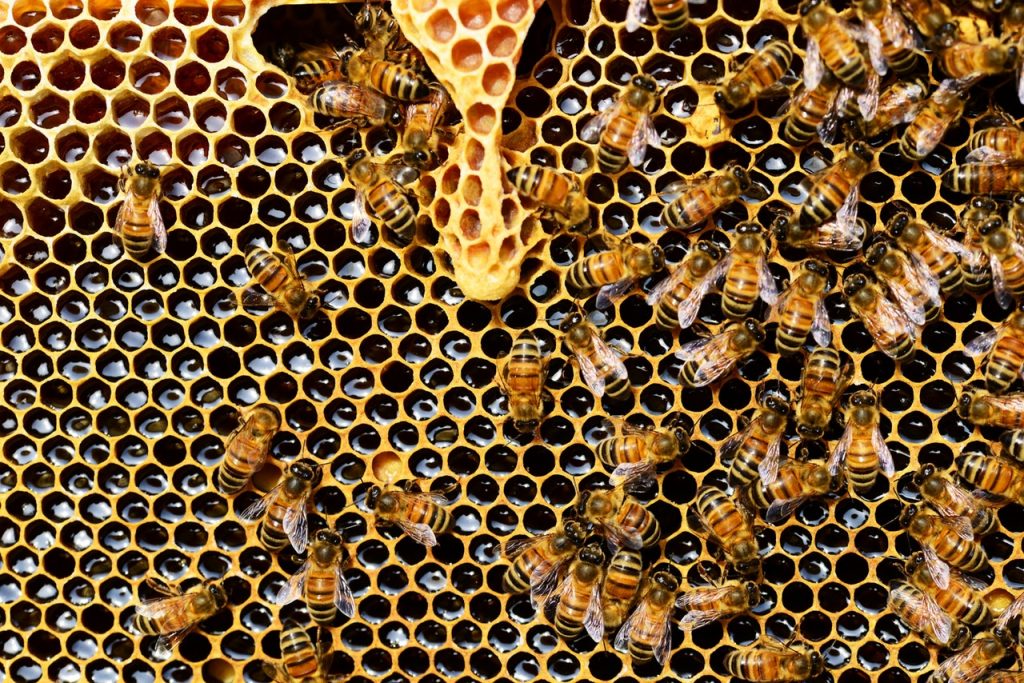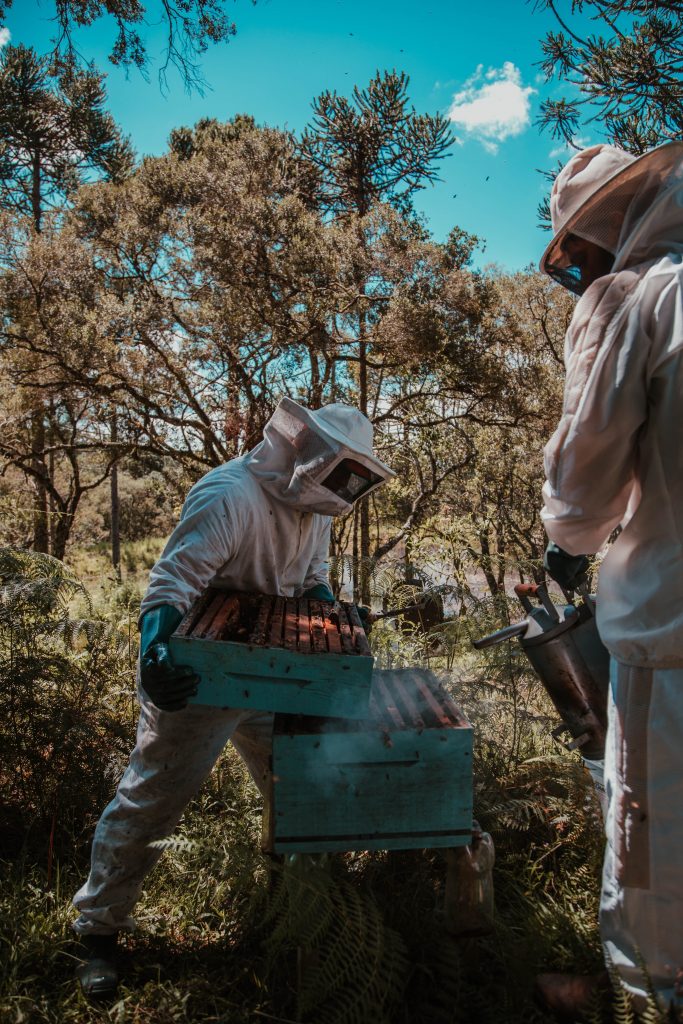
This is a really common question and one that the philosophy of vegan living has a straight answer to.
That answer being;
No, honey is not a vegan-friendly food.
So why the confusion?
As veganism has gained popularity in the last few years and there are now more vegans than ever before, more and more people have different views regarding the consumption of honey.
Those in favour of vegans consuming honey feel that it does depend on the person’s idea of what being vegan actually means;
As we know, vegans do not consume products from animals, and some people think that bees, being insects, are not animals. However, within the taxonomic categories (Domain, Kingdom, Phylum, Class, Order, Family, Genus, and Species), bees (arthropods) belong to the subclass Insecta, which in turn is one of the phyla of the kingdom Animalia. Bees are animals. A lot of people regard insects as being less important morally because there is currently not as much scientific data regarding their ability to feel pain, whereas this is beyond all doubt where mammals (Mammalia) are concerned.
Some people feel that avoiding honey is step too far, in a world that is still a long way from vegan living being the default for the majority. They believe that the focus should really only be the cruelty and exploitation of land animals, whose plight we can sympathise with and relate to so much more easily, at least until that harm is greatly reduced. They feel that telling others that vegans avoid honey as well will seem just too far for most people, (as even being vegetarian was seen as being too ‘out-there’ for the majority just a generation ago) and they think it risks turning people off adopting an otherwise vegan lifestyle.
Still others think that as honey does have many health benefits, (including natural antibacterial properties and the full spectrum of essential amino acids as well as many important minerals, and a host of other applications in wound healing) that perhaps it’s better to consume at least small amounts if the harm done is minimal. This is especially the case now that there are Flow™ hives that can be purchased from which the bees nor the honeycomb even need to be removed in order to access the honey, as it drips from a tap at the back. This of course does greatly reduce any harm caused to the bees during the harvesting of their honey.
Finally, a big consideration for most of those in favour of consuming honey is that of the gravely declining bee populations, which is a threat to our very own existence. They feel that beekeeping on a commercial scale is at least protecting the bees from extinction and therefore our precious crops. Of course they wish to support these efforts.
So what exactly is honey and why do bees make it?
We know you know that honey is the sweet, runny, usually amber-coloured stuff you buy in jars from the supermarket, and that it’s made from the nectar of flowering plants.
And as you likely know already, bees spend their days collecting nectar from flowering plants, and they bring this back to their hive. If they find a particularly good source of nectar, they will communicate this to other members of the hive via special ‘wiggle dances’.
We tend to think of bees flying around carrying the pollen on their little legs, but actually the nectar they collect is stored in a special little extra stomach they have, called a ‘crop’.
(This is why you might have heard some people – usually vegans – referring to honey as ‘bee vomit’. This is not correct, however).
There are special enzymes present within the ‘crop’, that mix with the nectar during the time it spends inside there. These enzymes alter the pH of the nectar, (a bit like when we add preservatives to food), which makes the nectar suitable for long-term storage. What you might not know is that not only do the bees regurgitate the nectar when they return to the hive, but they actually pass it to other bees who do the same thing with it, until eventually they decide it is suitable to be deposited into a honeycomb. The busy little bees then work even harder fanning their wings over the deposited liquid in order to dry it out. Now for the beeswax. When they are done with this process, the bees then secrete a liquid from their abdomen which dries and seals the honey in the honeycomb, – this is beeswax.
As you probably know yourself, honey lasts pretty much forever, and this is why the bees make it. They work hard at the equivalent of stocking up a pantry, since they will use this food to see them over the winter months when there are no flowers. Honey is the highly nutritious food that bees spend their time producing for themselves and their hive.
Did you know that it takes bees literally thousands of hours’ worth of time and effort to make just one 1lb of honey? They are busy bees indeed!

The land of milk and honey – not vegan
Given the reasons above, why do vegans not consume honey?
Well, firstly, going back to the definition of veganism;
Veganism is a way of living which seeks to exclude, as far as is possible and practicable, all forms of exploitation of, and cruelty to, animals for food, clothing or any other purpose.
This is the definition coined by Donald Watson, the founder of the Vegan Society, back in 1944.
It should be obvious that commercially produced honey does not come from wild hives. The bees’ natural environment and way of living is exploited specifically for human benefit. People generally seem to have a similar attitude to honey as they have to cow’s milk – i.e. they don’t really realise what honey actually is and what the bees use it for, (it is the bees’ source of food, just as cows’ milk is for calves) and then secondly, this idea that there is an ‘excess’, which otherwise goes to waste and therefore might as well be taken advantage of, – to the detriment of the bees. Honey is not ‘given’, – just as cows do not ‘give’ us milk. Neither do bees just sort leave their honey lying around, as if it were merely waste. The honey has to accessed at least in commercial honey production by getting the bees out of their hive.

In most cases, beekeepers smoke the bees out. This is the equivalent of you working hard all day to bring home a pay check to buy your food, and after you’ve gone and bought it, someone comes to your house and literally smokes you out of it. Whilst you’re outside trying to breathe and figure out what on earth is happening, they run in and empty your cupboards. Now because their food has been taken, it must be replaced with something otherwise the hive will die, and the beekeepers are not always done with them yet. So the honey is replaced with a sugar solution, which naturally does not compare with the nutrition provided by their own honey! How many honey harvests will be done with a particular hive will depend on the company and the different beekeepers involved. But when they are done with a particular hive, it’s not uncommon for them to be burned, all the bees inside along with it, because this is cheaper than keeping unproductive bees. You see the same story with any creature held captive in a capitalist industry, they can only ever be seen as resources, and once resources are no longer productive, they are destroyed. For living creatures of course, destruction is death.
But many, many bees are killed during the harvesting of honey. And this is on top of the removal and replacement of the honeycomb slats, during which many bees are crushed because of how they are flying around and how they cluster on the edges. Bees usually die when they sting. This is because most of the things they sting when prompted, such as human skin and clothing, are too thick to retrieve the stinger from. As the bee flies off with the stinger still caught, their abdomen is torn open. Bees will die to protect the hive. Beekeepers have to wear protective clothing because the bees will sting and try to go after the threat. This is also one of the reasons the smoke is used, as it temporarily drugs them and makes them sleepy. It is not enough however, and some bees are always crushed when the honey is removed.
A common practice in commercial beekeeping is to clip the wings of the queen bee, in order to prevent her flying off and creating a wild hive somewhere else and also because it helps to prevent the bees from forming a dangerous swarm when the hive is opened. It is clear that from this perspective, consuming honey is definitely not vegan.
Not to mention that it often has bits of wings and legs in it too.
But the deeper issue in this debate is about the declining bee populations. There are many different species of bees, and not all of them produce honey that is fit for human consumption. Many people worry that if all commercial beekeeping ended tomorrow there would not be enough honeybees left to pollinate the crops, and with an ever increasing need for more food as the human population grows, this is quite worrying. However, commercial beekeeping has also been implicated in the spread of diseases that are contributing to the overall decline in bee populations, so whilst veganism itself might be clear on honey being none of your ‘beeswax’, there is no easy answer as regards how to best help bees and ensure the future survival of the most prolific pollinators, – honey bees. Some vegans and some bee enthusiasts have begun to keep small hives, (from which they may or may not take any honey, hopefully the non-vegans that do take honey are using the Flow™ hives though this cannot be guaranteed), in a bid to help support the population. These efforts alone however, are likely not enough.
What to do then?
We don’t feel that consuming honey fits the definition of veganism. We are not here to tell you what to do, but if you do want honey without the associated ethical issues, there are few great alternatives from which to choose;
Bee-Free Honey™
Grace’s Vegan Pantry Pineapple Honey™
Agave Nectar
Maple syrup


